|
|
Advertisement:
|
|
Palomino and Thoroughbred Copper Cap |
|
Join the community - in the OCAU Forums!
|
CPU cores are made of silicon and that is brittle like glass. Nobody knows this better than users of AMD's Athlon CPUs. Due to well-known thermal reasons a heatsink has to be firmly mounted on the CPU and this heavy piece of metal is the natural borne enemy of the little brittle Athlon core. Chipped off core edges mean in most cases the immediate CPU exitus. Sadly, that is not at all uncommon. In Japan some vendors are offering AMD CPU with break insurance. For a small surcharge on top of the CPU retail price, a damaged CPU can be changed once within the first year after purchase. Of course, brave AMD owners rely on their skills as professional overclockers and proudly work their precious CPU without insurances or protection. The more realistic ones are using a support frame. Such a support frame, "shim", is normally sufficient to prevent damage to the core but not 100% safe. We have recently managed to break a Palomino core with a Swiftech MC 426 despite using a shim. We apologize to AMD for being clumsy.
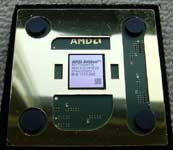 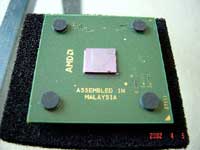
If the shim and the core are not 100% at the same height or the sink bottom is not 100% flat, the sink can still damage the core. These problems are alien to Pentium 4 users because the Pentium 4 has a heat spreader. This metal jacket is not only spreading the core's heat but also protecting it from the heatsink. Why do Athlons come without a heat spreader? Hapless Athlon users have asked this question and never gotten an answer. They may look to the land of the rising sun where a company specialized on in PC accessories like fans and heatsinks is now offering heat spreaders for AMD Palomino and Thoroughbred cores. We had a closer look at the Thoroughbred heat spreader. Actually they call it a "cap", which is probably better reflecting the intended purpose: “Cap your risk!” Despite this auspicious name we found in red letters written on the envelope containing the "cap": "All on your own risk!"
Manufacturer: Shinwa Sangyo
Address: Komae, Izumi Honcho 1-10-1, Tokyo 201-0003, Japan.
Telephone: 0081 3-3488-1536
Item Number: SS-SKTATRB-CAP
Material: Copper, polished
Length: 26 mm
Width: 23 mm
Height: 0.8 mm
Height on top of CPU: 0.15 mm
Street Price (Tokyo): around 16 USD / 16 EURO / 27 AUD
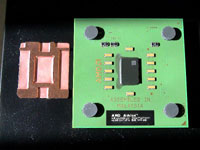 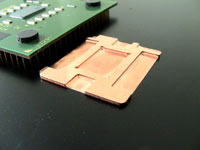
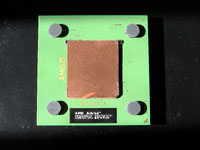 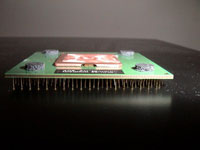
The pictures are self-explanatory. From a thermal point of view an additional layer between the core and the heatsink is not desirable. Even being copper, such a metal layer slows down the heat transfer from the core into the sink. That's the reason why some brave P4 users take away their heat spreaders. So how is the cap working? We had a look into the attached manual.
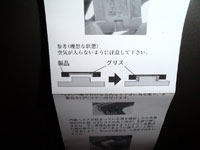
Aha! Grease, not “too soft”. Shinwa Sangyo is recommending their own grease G-765 and G-750 has to be applied not only on top of the cap but also between the cap and the core. Of course! That makes sense. We applied a not too thick film of Arctic Silver on the core (we know our trade!) put the cap on the core, put another thin film of AS on the cap's surface and mounted the sink. We used the AMD stock sink, which is part of the AMD retail box. One might expect that the sink is not fitting anymore because of the additional metal plate between the core and the sink. But not so, the "plate" is more a foil and so thin that the elastic spring mechanism fixing the sink on the socket is absorbing this height difference.
Now the surprise: we expected the temperature to increase a little with the cap. But what we got were around 5 C° more. That was certainly too much. We had another look into the manual and found that we oversaw an important detail: the grease has not to be applied on the surface of the core as we did, but inside of the cap. It has to cover the walls of the space that is surrounding the core to prevent air pockets. This way the core is completely covered by grease from all sides after the cap has been mounted. No pain, no gain! We dismounted the sink and reapplied everything as instructed. The temperature went down by 3 C°. It stayed however around 1 C° ~ 2 C° above the core temperature without the cap.

Conclusion: The “cap” works. The CPU is much safer with this cover. Only really extreme pressure extended on the heatsink could damage the core. However, the cap is naturally slightly increasing the core temperature. That might be one reason why AMD has so far refrained from putting such a cap on their relatively hot running Athlon core. The hardcore overclocker fighting for every degree Celsius or Fahrenheit for sure will stay away from this “cap”. For the more casual user the “cap” might be an interesting alternative to a shim.
We don't currently know of anyone selling these outside Japan. However, now we have made the manufacturer's details public, perhaps an interested distributor will bring some into Australia.
Added your PC to the PC Database yet?
|
|
Advertisement:
All original content copyright James Rolfe.
All rights reserved. No reproduction allowed without written permission.
Interested in advertising on OCAU? Contact us for info.
|

|


